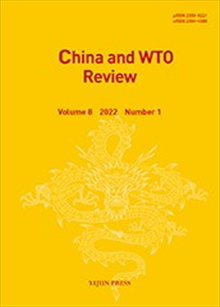간행물
China and WTO Review KCI 등재 SCOPUS

- 발행기관 이준국제법연구원
- 자료유형 학술지
- 간기 반년간
- ISSN 2383-8221 (Print)2384-4388 (Online)
- 수록기간 2015 ~ 2023
- 주제분류 사회과학 > 법학 사회과학 분류의 다른 간행물
- 십진분류KDC 341DDC 321
권호리스트/논문검색
Volume 1 Number 2 (2015년 9월) 5건
Article
1.
2015.09
구독 인증기관 무료, 개인회원 유료
Over its 20 years of practice, the Appellate Body gradually established a de facto stare decisis rule similar to that exists in common law system. Given the tight time constraint as provided in the DSU for an appeal process, the Appellate Body may face a situation where there is no sufficient time available for it to consider thoroughly all the elements for the interpretation of a provision, especially arguments or evidence of law that have not been raised even by the parties nor by the panel. If the issue whether Article XX of GATT 1994 can be invoked by China to justify a violation of paragraph 11.3 of its Accession Protocol had been decided in China-Raw Materials, can this issue be reopened and assessed again in China-Rare Earths? The author explored these two cases in light of the relevant WTO precedents as well as the common law thinking. This article concludes that it is both necessary and technically feasible to correct certain previous interpretation. Such a correction will contribute to further improvement in the clarification and interpretation of the covered agreements and accession protocols; hence give more confidence to Members that their rights and obligations under the treaty can be well preserved by a system with a built-in self-correction mechanism.
8,100원
2.
2015.09
구독 인증기관 무료, 개인회원 유료
The Framework Agreement for the ASEAN-China Free Trade Area was initiated in 2002. It is the first ASEAN Plus pattern free trade agreement in East Asia. To understand the cultural and historical bonds between China and Southeast Asian States, and contemporary Chinese regional political economy in building the ACFTA, this paper reviews the tributary trade and ancient Chinese diplomacy between China and the neighboring States. The primary purpose of this research is to show how the ACFTA is in the interests of all parties in the course of China’s fast economic and political growth. The following article highlights the ACFTA provisions by examining trading agreements in goods, services and investment in the context of the corresponding WTO provisions. In the end, it suggests the possible resolutions for achieving a win–win and interdependent ASEAN–China Free Trade Area.
7,800원
3.
2015.09
구독 인증기관 무료, 개인회원 유료
Trademark law is but part of competition law. With a good faith clause, the new Chinese trademark law moves closer to competition law. The new law is more liberal to the registrable signs with more non-traditional signs such as sound marks and flora in the family of registrable signs. Some kind of bona fide prior use of trademark is respected and the requirement of trademark use is strengthened in the new law. The likelihood of confusion has been absorbed in the new law as the prerequisites trademark infringement other than using identical marks on identical goods or services. In the new law, a clause against using well-known trademarks as tool to promoting products is formulated. Changes on the procedures of oppositions to trademarks witness the efforts to simplify the examination of trademarks. The stronger protection efforts such as punitive damages in the new law will go against trademark infringement.
6,700원
Current Development
4.
2015.09
구독 인증기관 무료, 개인회원 유료
When a State becomes the contracting parties to multiple FTAs concurrently, the State has to face serious challenges since all these different FTAs present different rules in certain segments of the agreements. All the participants are thus forced to walk a tightrope as one government is now supposed to play by many different playbooks. It is time to understand the real impact of the FTAs on the current trade regime, so that the States can take an informed decision when they devise their respective FTAs. Given the continued failure to complete the deals in the Doha Development Agenda, it is necessary that the States purport to negotiate and conclude bilateral or regional trade agreements with like-minded countries, and apply new rules of trade through such agreements. But the consequence of such regional experiments of fragmented rules should not be forgotten, in particular, concerning the long-term impact on the multilateralism. This article argues that the real impact of FTAs, particularly multilateral ones, does not lie in mere preferential tariff concessions, but rather gradual dismantling of multilateralism through incorporation of fragmented rules of trade. In this respect, China’s role is critical in devising and implementing FTAs in a way that can also help preserve the multilateralism.
5,200원
5.
2015.09
구독 인증기관 무료, 개인회원 유료
After the catastrophic financial crisis in of 2008, a significant portion of the legal academia in the globe has started to concentrate on the interrelationship between law, financial stability and economic development. Through reviewing the voluminous literature in this field, it is figured out that the scope of law has been largely confined to strengthening regulation of the pre-crisis unbundled derivative transactions and enhancing cooperation among sovereign States by making formal sources of international law. Few discussions have been made to scrutinize the existing regulatory structures for the domestic financial markets of sovereign countries and demonstrate the potential possessed by informal international law in reinforcing the efficacy of these regulatory structures. By comparing the financial regulatory structures in Hong Kong, Mainland China, the UK and the US and the core principles of the BIS, the IOSCO and the IAIS, this article attempts to fill in the above research gap to some extent.
5,500원

